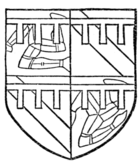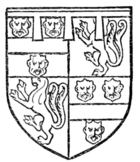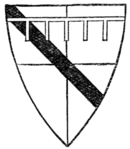Sir Patrick Dunbar, son of the Earl of Lothian (i.e. of March), then bore arms similar to his father, with the addition of a label "azure." On the other hand, Sir John de Segrave is said to bear his deceased father's arms undifferenced, while his younger brother Nicholas carries them with a label "gules"; and in the case of Edmund de Hastings the label is also assigned to a younger brother. Further proof of its being thus borne by cadets is furnished by the evidence in the Grey and Hastings controversy in the reign of Henry IV., from which it appeared that the younger line of the Hastings family had for generations differenced the paternal coat by a label of three points; and, as various knights and esquires had deposed to this label being the cognisance of the nearest heir, it was argued that the defendant's ancestors would not have borne their arms in this way had they not been the reputed next heirs of the family of the Earl of Pembroke. The label will be seen in Figs. 690, 691, and 692, though its occurrence in the last case in each of the quarters is most unusual. The argent label on the arms for the Sovereignty of Man is a curious confirmation of the reservation of an argent label for Royalty.

Fig. 692.—Arms of William Le Scrope, Earl of Wiltes (d. 1399): Quarterly, 1 and 4, the arms of the Isle of Man, a label argent; 2 and 3, azure, a bend or, a label gules. (From Willement's Roll, sixteenth century.)

Fig. 691.—Arms of John de la Pole, Earl of Lincoln (son of John, Duke of Suffolk), d. 1487: Quarterly, 1 and 4, azure, a fess between three leopards' faces or; 2 and 3, per fess gules and argent, a lion rampant queue fourché or, armed and langued azure, over all a label argent. (From his seal.)

Fig. 690.—Arms of John de Lacy, Earl of Lincoln (d. 1240): Quarterly, or and gules, a bend sable, and a label argent. (MS. Cott. Nero, D. 1.)
William Ruthven, Provost of Perth, eldest son of the Master of Ruthven, bore a label of four points in 1503. Two other instances may be noticed of a label borne by a powerful younger brother. One is Walter Stewart, Earl of Menteith, the fourth High Steward, in 1292; and we find the label again on the seal of his son Alexander Stewart, Earl of Menteith.
At Caerlaverock, Henry of Lancaster, brother and successor of Thomas, Earl of Lancaster—
- "Portait les armes son frère
- Au beau bastoun sans label,"
i.e. he bore the Royal Arms, differenced by a bendlet "azure."

